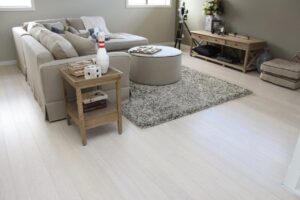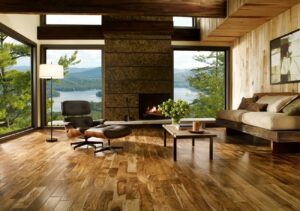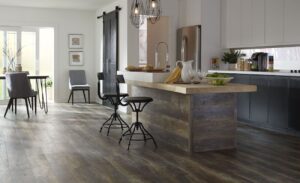Defining floating bamboo flooring has nothing to do with the way the materials constructing the floors or even the way the floors are connected to the subfloors. Instead, it deals with the way it connects from one individual bamboo planks to another planks.
If you associate floating bamboo with the engineered bamboo, you are likely wrong. However, floating bamboo planks can be constructed from solid composite materials and engineered veneer materials.
What Is Actually A Floating Floor?
Floating floors are defined as one of the flooring installation in which the materials are floating over both the subfloors and underlayment.
It is more about a method of installation that is widely used in a variety of materials including laminates, luxury vinyl flooring and engineered hardwood.
Click-Together Floating Bamboo Flooring
Floating bamboo planks are constructed and processed by the manufacturer in order that the individual pieces of planks can fit each other, snapping the whole installation together.
This floating floors allow you not to nail the material down to the subfloor. All you need to do to install this kind of flooring is to use the click-together installation technique.
Read Also: Tesoro Woods Bamboo Flooring Review
Easy Installation of Floating Bamboo Flooring
The feature of “click-together” installation technique added to floating bamboo flooring makes the installation process relatively easy. This technique is very much effortless due to the fact that you need not using adhesive, nails or something else to get the flooring materials covered in the subfloors. These floating planks are designed to fit one to another, easily snapping easily into the place.
Fortunately, this floating bamboo floors make you able to carry out DIY installation, meaning that you can install the flooring by yourself without hiring any professional installer.
Just make sure that you follow all of the instructions well based on the guidance provided by the manufacturers. Though you can install the flooring easily, careful installation and professional maintenance should be performed well to ensure the durability of bamboo flooring.
There are some big benefits you can derived from installing the floors by yourself. Firstly, you can cut down your installation budget so that you can save more money to use for other things.
Secondly, you can increase your DIY skills to do more self-installation, enabling you to save expense of hiring a contractor come into your home.
Humidity Changes
You may find that humidity and moisture changes can be a big problem for hardwood or bamboo flooring. Yet, it isn’t so for floating bamboo flooring. This is due to the fact that planks are not adhered to the subfloors.
They are just fit together with the other pieces of the planks, thus, there will be no restraining when they shrink. Although you notice that the planks are easily expanding and contracting because of the humidity and moisture changes, they will not cause stress like many other wood flooring.
Hence, floating bamboo floors are good to use for spaces with the high level of humidity such as bathroom, laundry room and kitchen. This floating planks also comes with the higher durability compared to the nailed-down applications.
Floating Bamboo Floors Resale Value
Thinking about reselling your old-fashioned floating bamboo floors requires you to know the resale value of the flooring product. Well, you might come to the peak of the boredom over the bamboo flooring in your home and you want to replace it with another stylish flooring, it is just possible.
Though many people think that this flooring is not as stable and durable as the regular hard flooring, floating bamboo floors quality remains good as long as the homeowner perform a proper installation and maintenance.
Floating Bamboo Flooring Replacement Consideration
Floating bamboo flooring is installed using the simplest way that is click-together technique at which you need just to fit the individual planks to another easily. This means, when there is a damage on one of the planks, you’ll be able to easily remove it and replace it with another piece of plank.
Beneficially, it help you save the repairing cost. Additionally, you don’t have to repair and replace the entire floor in your space, right?
Laminate “Engineered” Bamboo Floating Floors
Bamboo floorings are all engineered. And even the solid bamboo is constructed from a strips of the grass stalks, sliced and pressed together to form a plank. However, engineered bamboo floors are much associated with the laminate when it comes to talk about floating floors.
In fact, laminate floor planks is mostly constructed from a backing layer along with the filler. The laminate material surface is made of a thin layer of bamboo materials. Through the best treatment added, the laminate comes with the great look as a flooring type.
This laminate manufacturing is finished by being protected with an invisible sealant layer all over the surface, providing a great protection on the veneer slice so that the flooring will not get stained or damaged.
Laminate floating bamboo floors is relatively simple and easy from start to finish. They are designed in such a way to assemble and available for DIY option even by an amateur.
This means that you can install the floors easily by yourself even you are skillful enough or you just a beginner. As long as you perform the proper installation based on the manufacturer’s guidance, the floors will be stable and durable enough.
Furthermore, it is also extremely piece of cake to take care of the floors. Simple and low maintenance such as cleaning the floors regularly by sweeping and vacuuming the debris is just the best way of keeping the floors clean and tidy.
Alternatively, you can wear layer to give the floors protection so that the materials are well-protected from any substances that endanger the floor.
Solid Bamboo Floating Floors
Basically, there are always two types of flooring either in wood or bamboo. In this case, solid bamboo floating floor is manufactured by the natural stalk material, sliced down into a thin form and adhered altogether using the chemical bonding agents.
Later on, the materials are pressed down to using the heat and pressure to form solid planks. Along with the treatment of stains, sealers and paints, the solid bamboo floating floors are finished with the wonderful colors and great protection on their surface.
Being distinctive from engineered bamboo, solid bamboo comes more in natural look and feel than the laminates. Furthermore, refinishing is probably fine though you may need a help of a professional to handle the job.
Floating Bamboo Flooring Functional Applications
Floating bamboo floors is amazingly recommendable for some environments where the humidity may change over time. It is because this flooring is able to resist the damaged caused by the fluctuations of moisture, humidity or atmosphere in the room.
Moreover, this floating bamboo can be easily installed almost on all types of subfloors that the other flooring materials wouldn’t be able to apply on. This allow you to install the flooring simply on the existing flooring.
Floating Bamboo Floors Pros and Cons
Now you may have a question on your mind. Is a floating bamboo floors right for you? If you are still doubt whether to choose it or not, you would be better make a summary of the flooring in short dealing with the flooring pros and cons.
Fortunately, floating bamboo floors are affordable. It comes with an inexpensive price to suit your “on budget” situation. It is also easy to replace the damaged planks without the need to replace the entire floors in your spaces.
One more thing, floating bamboo floors are just easy to install. It provides you with the DIY option, allowing you to install the floors by yourself without sending expense for hiring professional.
The only downside of this floating bamboo floors is the lower real estate value. Therefore, some people tend to choose other flooring types which has a variety of styles options. However, in most home flooring, floating bamboo is still a good choice.
Maintenance and Repair
Specifically, maintaining and repairing floating bamboo floors is not as hard as you may think of. While laminate and vinyl floating floors need merely a damp mopping, the floating bamboo floors need only sweeping and vacuuming.
Damp mop is applicable for the difficult stains, however, it is much recommended that you dry the floors immediately. Just avoid water in cleaning the bamboo floors to keep it undamaged.
Repairing this floating flooring type is much easier than the glued-down or nailed-down flooring because you can possibly disassemble the floating floors and replace the damaged planks.
Read Also: Teragren Bamboo Flooring Review
Final Words
In short, having this floating bamboo floors is a good option for a person with the hectic activities. The easy installation as well as the low maintenance will make life much easier. This floating flooring type has all its benefit to resist any damage caused by the humidity fluctuations.
Furthermore, an easy repair just permit you to easily remove the broken plank and replace it with another piece of plank without replacing the whole floors. This is one of the benefits that most people are looking for.





